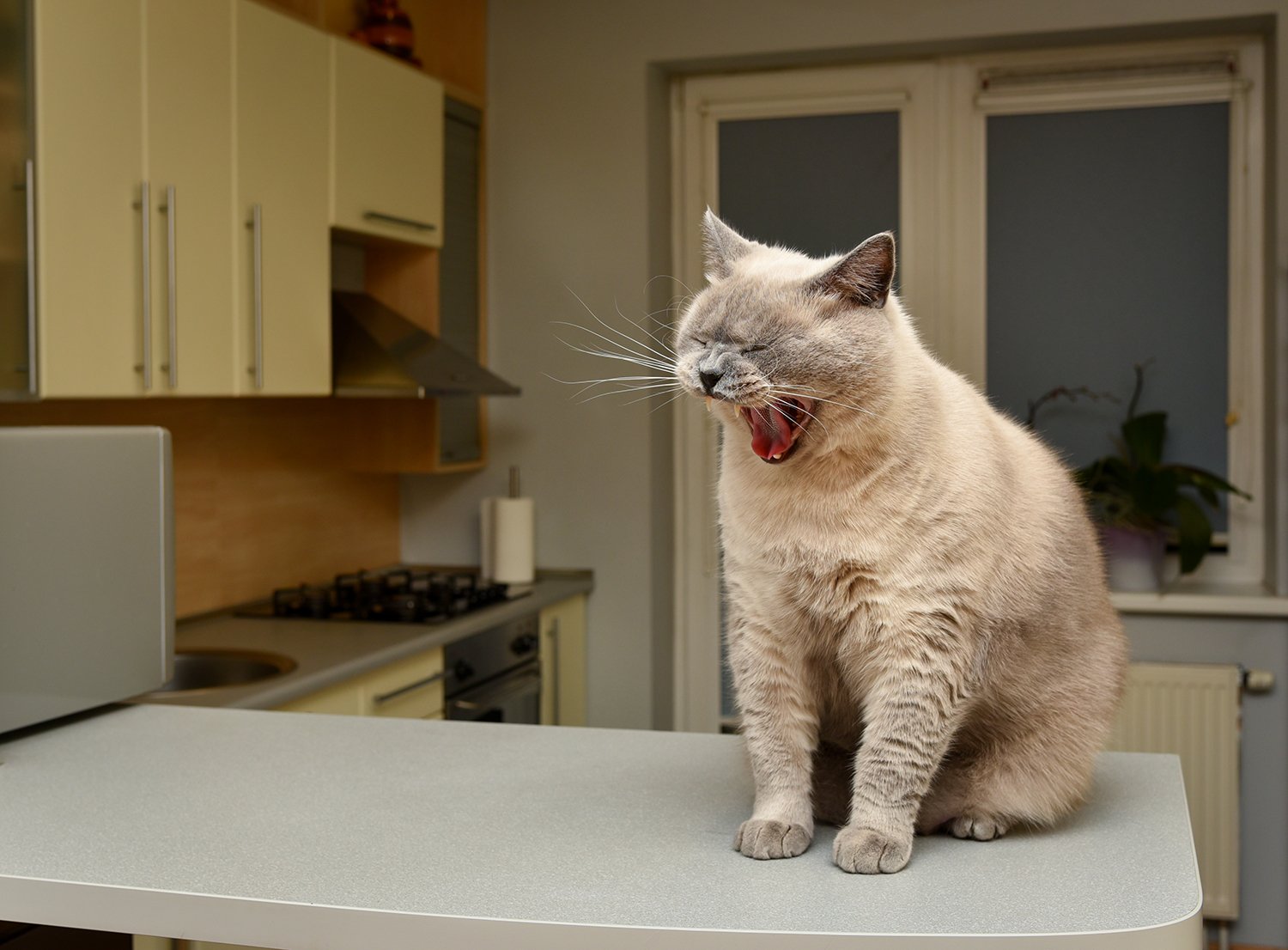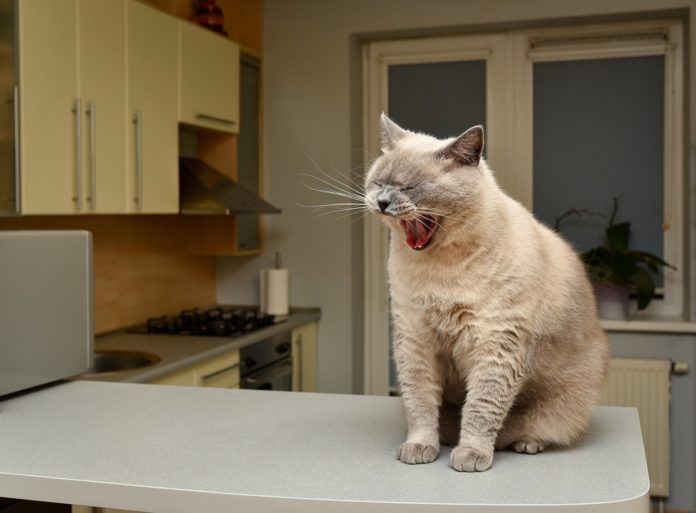© Sjankauskas | Dreamstime.com


You start chopping vegetables for dinner and there’s your favorite companion — right on the countertop nearby, rubbing himself against the microwave oven. You love your cat, but this behavior doesn’t make you happy.
“Like many owners, I dealt with it with my own cat,” says Stephanie Borns-Weil, DVM, a specialist in behavior at the Tufts University Cummings School of Veterinary Medicine. Her concern wasn’t just about the hygienic issue of a cat going from a litter box to a place where food is prepared. She was also concerned about the safety of her cat. “At our home, the stoves are flat surfaces, so I was afraid the cat would get burned and injure her paws.”
If you, too, are concerned about your kitten or cat jumping on kitchen counters, dining room tables or even shelves that hold your fragile family heirlooms, it’s comforting to know that there are solutions, says Dr. Borns-Weil. The best ones, however, arise first from understanding both the biological and psychological needs that your cat satisfies by this jumping behavior.
According to Dr. Borns-Weil, “We can stretch to meet our cats’ needs and they can stretch to meet our needs, too. By gently discouraging your cat from being on certain surfaces — and making sure that you provide plenty of alternative surfaces that he enjoys — you can ultimately meet both your needs for hygiene and your cat’s need for an elevated resting space.”
Why Do Cats Jump?
Before you try to change jumping behavior, take a moment to understand its deep biological roots. “Domestic cats are descended from tree-dwelling cats,” says Dr. Borns-Weil. (That evolutionary ancestor is the “wildcat,” Felix silvestris.) “Although they live in our houses now, they still prefer to be in high places when possible. Being in high places is natural for cats. We have to acknowledge that they have a certain biological need to be up on high surfaces.”
Additionally, your cat may be jumping up on surfaces to be near — you. “Perhaps you’ve been out of the house all day, and your cat may simply be lonely,” she says. “People have the notion that dogs require a lot of work, whereas cats are self sufficient. But in truth, the modern cat’s life is very controlled. They don’t have interesting lives chasing mice and worrying about territory and other cats. So when your cat jumps on the counter, she may simply be vying for your attention.” That’s true even if the jumping upsets you. To your cat, she says, “bad attention may be better than no attention at all.”
With this background of biological and psychological needs, the solutions become obvious. Certainly, use behavioral tricks to gently make certain surfaces less attractive — while moving fragile heirlooms to safe spots. But these approaches will work better if you provide your cat with ample opportunities to exercise his biological desire to survey the world from a strategically high spot, and satisfy his psychological needs for attention and play.
Methods that work
Dr. Borns-Weil recommends a combination of techniques to redirect the natural vaulter you’re living with:
Make target surfaces unappealing.
“You can roll out foil or bubble wrap, or tape with the sticky side up, on the side of the counter,” she suggests. “You can also spray surfaces with a non-toxic lemon-flavored substance that they won’t want to get on their paws. Most cats don’t like citrus odors or flavors.” You don’t have to live permanently with sticky tape or lemony oils on your counters, however. Just use them to break your cat’s habit of jumping on that surface.
Use clicker training.
“You can teach your cat to get off a surface on command. Cats are good learners and usually find positive reinforcement training to be fun.” Here’s how: Get a clicker and a feather. Use the feather to get your cat’s attention. Once you have it, use the clicker while saying something like “off” — when your cat jumps down, reward him with a food treat. “It’s fun to train cats,” she says. “They are smart and really enjoy it.”
Create alternative high spots for your cat to perch on.
It can be as simple as a fluffy pillow on a windowsill, or as complex as a series of cat shelves on walls with mats so your cat has a choice of several different levels from which to peer down. “Cats can never have too much vertical space,” says Dr. Borns-Weil. Provide good sight lines, too. “Cats generally prefer to be where the action is — where the family hangs out and where there is a view of the outside,” she says.
Provide vertical environments that are fun for play.
“The most useful products are those that contribute to a more enriched environment for your cat. If there are plenty of interesting things for a cat to do — foraging toys, prey-like toys, cat grass to munch on, regular play time, window seats — they will be happier and better adjusted pets. It won’t keep them off the counter per se, but it will keep them happy and occupied and less apt to just lie around.”
Play with your cat.
“When you get home, make sure your cat has physical exercise, and fun and games,” she suggests. Now that most cats live indoors, instead of indoors/outdoors, they rely on us more for play and exercise. “If your cat is tired when you are preparing dinner, she’s unlikely to drive you crazy.”
Cat-proof your home.
When you have a toddler at home, you may need to retire that glass coffee table for a few years. The same holds true for natural feline jumpers. Put that family heirloom behind a glass cabinet door, or in a room that is off limits.
Narucha Klinudom | Dreamstime.com


Avoid punishment
By giving your cat places to perch — and opportunities for exercise and play — you may not only help discourage unwanted jumping, but also have a happier cat. Just make sure you don’t damage your relationship with harsh punishments marketed to discourage jumping and other behaviors. “I’m not a fan of water pistols, or spray bottles, or loud noises, or screaming in your cat’s face or throwing your cat on the floor,” says Dr. Borns-Weil.
She also warns about products such that provide an air blast, or mats that deliver an electric shock. “These punishments can be very upsetting to cats and create anxiety. I can’t help but feel that it’s not good for the person either. You’re doing something scary to an animal who is only one-twentieth of your size.” — Catnip staff
One Behaviorist’s Opinion: Embrace the Counter!
“Personally, I don’t understand why people would want to keep a cat off a counter,” says Nicholas H. Dodman, BVMS, Professor Emeritus at Tufts Cummings School of Veterinary Medicine. Dr. Dodman also strongly believes that humans need to understand a cat’s biologically-based need to get to high places. The difference is that he thinks that once we understand that, we’ll also want to let our cats express their biology freely.
“Cats are three-dimensional creatures,” explains Dr. Dodman, who is board-certified by the American College of Veterinary Behavior. “Horses and cows may be fine staying on a flat plane, but not cats. They are climbing animals. They go up in branches, up in trees. That natural behavior should be catered to by an owner — unless he or she wants a neurotic cat.”
He believes that we should adjust our environment to our cats, rather than vice-versa. “Make sure they have access to elevated spaces,” he says. He suggests window inserts, carpeted cat posts with different climbing levels, ladders on bookcases, even plate-like cat shelves where cats can sit. “The way to keep a cat happy is make the house as cat-friendly as possible. My cat sits on a book counter, jumps from the balcony to the bookcase and nests there, happily looking down at the television.”
Trying to keep your cat off surfaces can make your cat anxious and harm your relationship, he believes. “If you yell at your cat, push it off the counter, set booby traps or use electronic shocks, you could end up making your cat bitter and anxious,” he says. “I actually feed my cat on the counter. I have dogs also, so I’ve fed my cat on my counter, where I also prepare food, for 25 years. It hasn’t been a problem. When I’m about to do something like cut up a chicken, I’ll thoroughly clean the countertops.”




